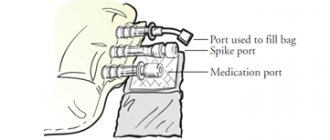Anesthesia (anesthetics, general anesthetics) are medications that cause anesthesia - a temporary loss of consciousness and all types of sensitivity, primarily pain. In large doses, anesthetics inhibit reflexes and cause deep muscle relaxation.
Another name for anesthesia is general anesthesia.
It is important not to confuse general anesthesia with local anesthesia. With local anesthesia, the loss of pain sensation is limited to a small area of the body around the injection site of the local anesthetic. In addition, with local anesthesia, the patient is conscious, unlike general anesthesia.
Any anesthesia occurs in four stages:
- The stage of pain relief (analgesia) is the loss of pain sensitivity, but the patient is still conscious.
- Excitation stage – speech and motor excitation; a very short stage, practically absent with modern anesthetics.
- The stage of anesthesia is loss of consciousness, decreased muscle tone, suppressed reflexes. Depending on the depth of general anesthesia, superficial, light, deep and ultra-deep anesthesia are distinguished.
- The stage of recovery from anesthesia is awakening. In case of an overdose of anesthesia, the exit stage is replaced by the agonal stage with respiratory depression and cardiac arrest.
All anesthetic drugs have a rapid effect, causing the patient to black out within a few seconds of the start of administration.
Indications for use
Anesthesia is used for various surgical interventions (operations), including for pain relief for short-term operations in dentistry, gynecology, childbirth anesthesia, traumatology (fusion of dislocations, fractures).
Certain anesthetic drugs are used to eliminate severe pain and prevent pain shock in myocardial infarction, acute pancreatitis, multiple injuries (for example, car accidents, falls from a height), severe and extensive burns.
Anesthesia can also be used to relieve (eliminate) status epilepticus, a severe complication of epilepsy in which the patient’s seizures follow one another without stopping.
Read also[edit | edit code]
- Anesthesiology History of anesthesiology
- Anesthesia in the preoperative period
- Anesthesia during the intraoperative period Induction of anesthesia
- Maintenance of anesthesia
- Non-inhalational anesthetics Barbiturates
- Local anesthetics Cocaine
- Types of anesthesia
- Oxygen inhalation therapy Carbon dioxide in the body
- Nitric oxide in the body
- Helium (inhalation)
Basics of anesthesia treatment
Anesthetics are drugs that are subject to particularly strict accounting and control of circulation. You cannot buy them at the pharmacy even with a prescription. All anesthetic drugs are dispensed from pharmacies directly to clinics and hospitals using special documents - invoice requirements.
For anesthesia, the accuracy of their dosage is vital. To administer drugs for inhalation anesthesia, special anesthesia machines are used, which allow very precise dosing of substances delivered into the respiratory tract. Vapors of anesthetic drugs enter the lungs through an endotracheal tube, which is first introduced through the mouth and pharynx deep into the trachea. Non-inhalation anesthesia agents are administered intravenously.
For short-term operations, only inhalation anesthesia drugs are usually used. For long-term heavy operations, a combined anesthesia is usually used - both inhalation and induction - to ensure optimal general anesthesia.
The task of choosing anesthesia, calculating the dosage of drugs for a particular patient and constantly monitoring the course of general anesthesia during surgery (respiratory and cardiac indicators), as well as ensuring the patient’s recovery from anesthesia lies with the anesthesiologist.
Non-inhalational anesthesia
Non-inhalation anesthesia occurs when an anesthetic is administered parenterally into the body. Anesthetics are most often administered intravenously.
Barbituric acid derivatives
Sodium thiopental (hexenal) was first described in 1934. It is a green (sodium thiopental) or white (hexenal) powder. Available in bottles of 0.5 and 1 g. Immediately before anesthesia, this powder is dissolved with distilled water (isotonic sodium chloride solution) to 1% concentration.
Barbiturates have a pronounced narcotic effect (prevent consciousness) with a slight analgesic effect. Therefore, they are used for induction of anesthesia, excluding consciousness during painless manipulations. For pain relief during barbiturate anesthesia, narcotic analgesics (morphine hydrochloride, fentanyl) should be additionally administered.
Easy, pleasant falling asleep for the patient and the absence of agitation have led to the widespread use of hexenal and sodium thiopental in the practice of anesthesiologists. In addition, due to their pronounced anticonvulsant effect, barbiturates are used to relieve seizures in patients with epilepsy, tetanus, meningitis, eclampsia, etc.
Derivatives of barbituric acid have parasympathomimetic properties. Therefore, when using them, complications are possible: cough, bronchospasm, laryngospasm. They suppress the activity of the respiratory center; with rapid administration of large doses of sodium thiopental or hexenal, respiratory arrest may occur. Barbiturates can only be used if a ventilator is in working order.
The nurse (anaesthetist) prepares the anesthetic for anesthesia and administers it to the patient as directed by the anesthesiologist. To do this, under aseptic conditions, she dissolves 1 g of sodium thiopental in 100 ml of 0.9% sodium chloride solution (up to 1% concentration). After venipuncture and setting up the system for infusion therapy, the patient (as directed) is injected with 1-2 ml of anesthetic solution intravenously. Waiting 1 - 2 minutes, finds out whether the patient has hypersensitivity to sodium thiopental, whether the solution has got under the skin. Then he introduces the remaining drugs. The dose is purely individual (from 4 to 8 mg/kg body weight). Barbiturate anesthesia lasts 15-30 minutes. To continue narcotic sleep, 10-20 ml of a 1% solution should be re-administered or another anesthetic should be used.
Sodium hydroxybutyrate (GHB)
The sodium salt of gamma-hydroxybutyric acid (GHB) was first described in 1960. Available in ampoules of 10 ml of 20% solution. Has a pronounced sedative and narcotic effect. The analgesic effect is insignificant.
Sodium hydroxybutyrate is a drug derived from γ-aminobutyric acid, a natural metabolite of the body. Therefore, its use does not cause toxic effects in the patient. By being involved in metabolic processes, GHB normalizes cellular respiration; equalizes the transmembrane potential, transferring potassium from plasma to cells. Due to this, the excitability of the cells of the heart, brain and other tissues is reduced.
Sodium hydroxybutyrate is widely used in intensive care for patients with impaired functions of the cardiovascular system (in shock), with severe hypoxic conditions (in cases of clinical death, brain damage, in obstetric practice). The drug in an antihypoxic dose (20-40 mg/kg body weight) effectively affects tissue respiration, leveling it; without excluding the patient's consciousness.
As an anesthetic, it is the drug of choice for patients with concomitant diseases of the cardiovascular system, liver, and kidneys; pathology of endocrine organs; during neurosurgical operations; in case of pregnancy pathology. In addition to administration, it can be used intramuscularly, orally, or rectally.
To ensure narcotic sleep, GHB is administered at a dose of 70 - 120 mg/kg. The nurse (anesthetist) administers it intravenously as directed by the doctor, slowly, 10 ml. In order to prevent seizures, which sometimes occur, it is advisable to administer GHB with barbiturates. To do this, a 20-milliliter syringe is filled with solutions of sodium hydroxybutyrate (10 ml) and sodium thiopental (10 ml). This mixture can be administered quickly. Within 5-10 minutes the patient experiences a sleep reminiscent of physiological sleep. In this case, liquid, deep breathing, muscle relaxation, and suppression of reflexes are noted. Hemodynamics are not affected. Narcotic sleep lasts up to 1 - 1.5 hours, its aftereffect - up to 5 hours. At this time, the patient may experience a retraction of the tongue and impaired ventilation, which requires long-term monitoring.
Hydroxidion
Hydroxidione (viadril, predione) was described in 1941. It belongs to the group of steroid drugs that do not have hormonal activity. White crystalline powder is produced in bottles of 0.5 g. Viadryl solution has alkaline properties (pH 8.5).
Hydroxidione is a pronounced hypnotic, a less pronounced narcotic anesthetic that does not provide an analgesic effect. It potentiates the effect of barbiturates, analgesics, neuroleptics, and muscle relaxants. Viadryl does not have a toxic effect on the body, which is why it is used during operations on weakened patients with damage to the heart, liver, kidneys, and pancreas. The anesthetic suppresses cough and gag reflexes; Overdose may cause hypotension and bradycardia.
Hydroxidione is used as the main anesthetic for inducing a patient into anesthesia. To do this, the powder should be dissolved in a bottle in a concentration of 0.5-2.5%. The dose for anesthesia is calculated at the rate of 12-15 mg / kg (on average 80 - 120 ml of 1% solution). Due to the pronounced irritating effect of the media on the walls of blood vessels and the probable occurrence of phlebitis, the following rules should be observed when using it:
- inject the anesthetic into a wide-lumen vein (preferably a main one);
- before and after using the drug, 15-20 ml of a 0.25% novocaine solution should be injected into the vein lumen.
The duration of anesthesia is 30 - 60 minutes. To achieve adequate pain relief, hydroxydione is combined with narcotic analgesics, dinitrogen oxide.
Ketamine
Ketamine (ketanest, calypsol, ketalar, velonarkon, Petar) was described by Carsen and Domino in 1965. This is a group of drugs, the peculiarity of which is the ability to suppress the functions of some parts of the central nervous system and increase the activity of others, causing so-called dissociative anesthesia. Ketamine is a clear liquid that is unstable in light; Available in the form of a 1 or 5% solution in darkened glass bottles (10 ml each) or in ampoules (2 ml each). Ketamine is a potent anesthetic; induces deep sleep with moderate pain relief. Due to selective stimulation of certain parts of the brain (limbic structures), during monoanaesthesia, patients may experience visual hallucinations. In addition, ketamine causes slight neurovegetative inhibition, relaxation of striated muscles against the background of preserved tendon reflexes. It increases blood pressure, increases heart rate, mildly depresses breathing, and stimulates the production of cerebrospinal fluid (CSF).
Considering the peculiarities of action, ketamine is the drug of choice in patients with a deficiency of circulating blood volume (hypohydration, hypotension, various types of shocks, collapse), if it is necessary to carry out anesthesia with preserved spontaneous breathing. Due to the versatility of administration (intravenous, intramuscular and rectal), this anesthetic is widely used in pediatric anesthesiology.
Ketamine is administered intravenously at a dose of 2-3 mg/kg or intramuscularly at a dose of 7-10 - 15 mg/kg. In order to eliminate the unwanted hallucinatory effect, it is used together with a tranquilizer solution (1-2 ml of 0.5% sibazon solution). Ketamine can be combined with various inhalational and non-inhalational agents (as part of a combined anesthesia). Ketamine anesthesia is contraindicated in patients with hypertension, with cerebrospinal fluid hypertension (traumatic brain injury, epilepsy), and with mental illness.
Propanidid
Propanidid (sombrevin, epontol). It is a light yellow oily liquid that is poorly soluble in water. Available in ampoules of 10 ml of 5% solution. Propanidide is an ultra-short-acting anesthetic. When used intravenously, it ensures easy and quick fall asleep, with awakening after 4 - 5 minutes. Due to this, it is used in outpatient practice for short-term operations (reduction of dislocations, comparison of bone fragments in fractures, opening of abscesses and phlegmons, “minor” gynecological operations).
Immediately after the administration of the anesthetic, the patient’s breathing accelerates and deepens; after 30-40 seconds it slows down, until apnea (stop). Conducting Sombrevin anesthesia without a breathing apparatus is contraindicated! Since propanidide is an unstable substance, the solvent Cremaphor is used to stabilize it. It is one of the most dangerous allergens in the human body, capable of causing anaphylactic shock (in 1 case per 500-700 anesthesia, especially when it is repeated). This has caused a significant limitation in the use of Sombrevin at the present time. The anesthesia team should always be prepared to treat anaphylactic shock!
Sombrevin is a cardiodepressant drug, so it is used with caution in patients with cardiovascular pathology. It is contraindicated in case of bronchial asthma and a history of any allergies. For anesthesia, sombrevin is used at a dose of 7-10 mg/kg. The nurse (anesthetist) draws the contents of the ampoule into a 20 ml syringe, adds 3-5 ml of 10% calcium chloride solution and 0.9% sodium chloride solution (until the syringe is filled). Administer intravenously as soon as possible. It is not advisable to pull back the syringe plunger, since the flow of blood to the anesthetic inactivates it, which shortens the duration of anesthesia.
Altesin
Althesin (alphadione, alfathesin) was described in 1971. It belongs to the steroid drugs that do not have hormonal activity. This is a colorless sticky liquid, which is produced in 5 ml ampoules containing 60 mg of the active substance. Altesin is a pronounced hypnotic with weak analgesic properties. After administration of the drug, a stage of hyperventilation is first noted, which after 30 seconds changes to hypoventilation and apnea.
Altesin has a short-term effect (up to 10 minutes), due to which it is often used in outpatient practice. Has a large therapeutic breadth. Causes muscle relaxation. For pain relief during altesin anesthesia, it is advisable to use fentanyl and dinitrogen oxide. In therapeutic doses, altesin does not have a toxic effect on the liver and kidneys.
Respiratory depression and histaminogenic reactions, including possible anaphylactic shock, limit the use of this drug. Complications and their prevention are possible. Altesin is administered intravenously at a rate of 0.1 mg/kg body weight over 1 to 2 minutes. For long-term anesthesia during operations and diagnostic procedures, it is better to administer altesin dropwise using a dosing device.
Propofol (diprivan, isoprivan)
The anesthetic is produced in the form of a white fat emulsion in ampoules of 20 ml or bottles of 50 and 100 ml. 1 ml of the drug contains 10 mg of active substance. It can be administered with various infusion media other than blood and plasma (risk of demulsification).
Propofol has a pronounced hypnotic and sedative effect, and a slight analgesic effect. Therefore, for anesthesia it should be combined with analgesics. Administration of the drug at a dose of 2-2.5 mg/kg (15-20 ml) causes sleep within 40 seconds (criterion for the disappearance of the ciliary reflex). The duration of narcotic sleep is 20 - 30 minutes. Diprivan does not cause excitement, slightly weakens breathing, and has a weak hypotensive effect without tachycardia. Inhibition of the reflexes of the larynx and throat allows the use of a laryngeal mask (a means for maintaining the patency of the airways during spontaneous breathing or performing artificial ventilation).
Diprivan is used for induction of anesthesia and as a component of balanced anesthesia during long-term surgical interventions. To do this, the anesthetic is administered in repeated fractionations, every 20-30 minutes at a dose of 100 mcg / (kphv) - (2 ml) followed by a dose reduction with each injection; or continuously using a dispenser.
After diprivan anesthesia (even long-term), patients quickly awaken within 10 minutes. This feature, as well as the normalization of hemodynamics during laparoscopic surgical interventions, the minimum number of complications and contraindications, allow us to consider propofol as the drug of choice in modern anesthesiology.










